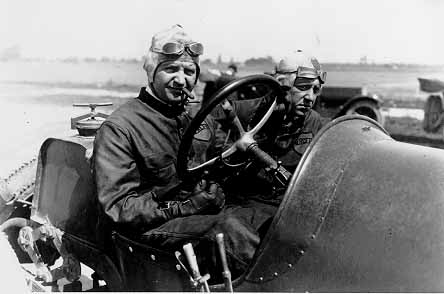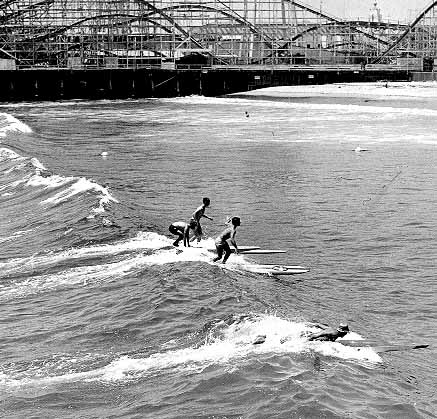Venice - Sports
Revised April 6, 1998
Venice, California has always been a sports oriented town. Its location adjacent to the Pacific Ocean has attracted residents and visitors who are physically fit and like the great outdoors. Naturally water sports dominated, but it was also a town that took to the latest sports and enjoyed watching them as spectators.
Roller Polo
Roller skating, which had become a popular pastime that year, by fall, became the rage in Southern California. Both the Venice and Ocean Park rinks were jammed nightly. Admission was ten cents and skate rental two bits (25 cents). The rink featured exhibitions of championship skaters, Friday night races, and the new sport of roller polo.
Venice quickly fielded a team in the fledgling Southern California Roller Polo League. They were handicapped in their first game against Long Beach because the team used ordinary ball-bearing skates, whereas their opponents used pin-bearing skates that enabled them to run, jump and stop quickly. Seven hundred enthusiastic spectators watched Venice defeat Long Beach 2 - 0 in their first home game in October. Games were held every Wednesday and Saturday nights and the local team made headlines by winning most of the time. But by Christmas, interest in the sport and roller skating in general waned. Venice's first fad had ended.
Gran Prix Racing

| The winner of Venice's 1915 Gran Prix was Barney Oldfield. |
A Saturday afternoon St. Patrick's Day crowd of 75,000 watched the 300 mile road race from the bleachers and anywhere they could find a view. Seventeen drivers entered some of the fastest racing machines of their day; Bugatti, Napier, Chevrolet, DeLange and Hercules. Mechanical problems plagued most of the drivers as one after another dropped out of the grueling race. Dave Lewis was in the lead on the 80th lap with just 17 laps to go when engine trouble forced him out of the race. Barney Oldfield's Maxwell went on to an easy victory with a time of 4 hours 24 minutes. Billy Carlson, also driving a Maxwell, finished second just 41 seconds behind Oldfield. Only eight of the seventeen entries finished the race and the average speed of the winner was 68.5 MPH.
The race was considered a success despite the death of a riding mechanic during a practice lap, injuries to bystanders when a scoreboard toppled, and the death of an elderly spectator who wandered on to the course and was struck by a car. However, the city lost $10,000 due to gate crashing and the sale of 1000 counterfeit tickets by con men. Despite 40,000 paid admissions, thousands rushed the gates and sneaked in when ticket takers were unable to handle the large crowds.
Baseball
Eddie Maier, owner of the local brewery, bought the Vernon baseball
franchise in the Pacific Coast League and moved the team to Venice Park
in Venice for the 1913 season. The ballpark was located on the southwest
corner of Virginia Avenue and Washington Boulevard (now South Venice Blvd.
and Abbot Kinney Blvd.) The six acre site was upgraded at a cost of
$12,500. New grandstands holding 3000 seats and bleachers for 4000 were
built. The outfield fence on the south side, set 325 feet from the home
plate, had a unique design; 3 feet of wood topped by six feet of wire mesh.
Eighty spaces were reserved for automobiles in the nation's first "drive-in"
ball park.
The team, managed by "Hap" Hogan, consisted of older major league players and younger hopefuls. Ex-major leaguers included Joe "Iron Man" McGinnity, Fred Harkness, John Kane, Dick Bayless, John Raleigh and Roy "Rhino" Hitt. They played Class AA baseball, one step below major league baseball in the east.
The grand opening of the park and the Tiger's first game on March 26, 1913 was an exhibition game with the Chicago White Sox's second team. The park's dedication was preceded by a parade which made its way to Venice from downtown Los Angeles. 4000 fans, including all of Venice's school children who were given a half day holiday and free admission, packed the grandstands and bleachers. Mayor Hoolbrook delivered the first pitch which was caught by Abbot Kinney, the catcher. The Tigers were no match for the White Sox who won the game 7 to 4.
The first Pacific Coast League game at Tiger Field was on Sunday April 6, 1913, when Venice lost to the Angels 3 to 2. The game was called during the Tiger half of the eight, because all Sunday morning games (the only games played at Venice's Tiger Field) were subject to a two-hour and fifteen minute time limit. This was to allow the clubs to catch the trolley to Washington Park in Los Angeles for the second half of the double header.
The Tigers traveled up and down the coast to play opponents in Portland, Sacramento, Oakland, San Francisco and Los Angeles. After losing the opening double header against Los Angeles 3 to 2 in both games, they eventually finished third in the league with a 107-102 season record.
While team owner, Eddie Maier offered to increase the number of games played at Tiger Stadium if attendance increased, apparently Venice residents weren't interested in the game. Attendance figures for the 1914 season weren't even enough to pay the interest on Maier's $40,000 investment. The crowd for the April 26th Sunday game was only 550. They finished the season in fifth place with a 113-98 record.
Maier had enough and on January 4, 1915 he announced that Venice would lose its baseball franchise to Vernon. The Tigers played their last game, which they won against the Angels, in Venice on June 13, 1915. The Angels, who also used the field on Sundays, played their last game, a win over Salt Lake City, on July 5, 1915. In all only 78 regular season games were played at Tiger Field by both clubs. Afterwards the Venice Park was dismantled and moved in sections back to Vernon at a cost of $7,500.
Boxing
Popular boxing "smokers" were held on the Venice Pier. They often featured motion picture celebrities in the ring. Former heavyweight champion Jim Jeffries was often the referee. There were also boxing matches at the pier Auditorium on Friday nights.
Luther McCarthy who was considered a possible challenger to heavyweight champion Jack Johnson, trained in Venice with his sparing partner John "Bull" Young. While McCarthy was very popular with the ocean front crowds, he died from an injury to the head in 1913 during a bout. Young, too, suffered a similar accident later that same year in a boxing match with Jess Willard at the Vernon arena.
Kinney turned down an offer to build a boxing stadium in the canals in January 1913. He declared, "Venice will continue to be a mecca for clean sport and amusement, but a fight arena - No!" He did permit boxing in his pier Auditorium, but the fights were always stopped before they became cruel.
Although boxing was banned in Venice later that year, in later years several Venice boxers became popular attractions at the Ocean Park arena and Olympic Auditorium. These included Kenny LaSalle, Ge Ge Gravante, Frank Duarte and Phil "Babe" Brandelli.
Swimming, Surfing & Water Polo
Venice's location adjacent to the Pacific Ocean and its year-round
heated salt water Plunge on the beach fostered a high interest in aquatic
sports. Venice residents as children learned to swim in the Plunge, and
later competed in swimming, water polo and paddleboard (surfing) events.
Swimming and diving competition in Venice began during Venice's inaugural opening weekend on July 4, 1905. The Southern California Swimming Association held their second annual swimming tournament in Venice's inland lagoon to a packed crowd of 2500 spectators seated in the Amphitheater. Afternoon events included a men's 100 yard race for the amateur championship of Southern California, a similar event for competitors under 16 years of age, and a 220 yard relay race where the winning team received a silver loving cup donated by Abbot Kinney. Jake Cox, a lifeguard and swimming instructor for the Venice Bathing Company, entertained and awed the crowd as he performed trick diving stunts from the high diving tower in the lagoon's center. The swimming event concluded with a high diving competition and a half mile challenge race swum in heats.
Venice's first water polo team was formed in July 1908 to enter a proposed league. Jack Cox was selected to coach, and George Freeth, the Hawaiian surfboard rider became a team member. The group practiced in the Plunge, but matches took place in the Surf Bathhouse. The 1909 team included; Sherwood Kinney (forward), A. Sholz (forward), Frank Holborrow (sprint), George McManness (guard), Marcus Lee (guard), and M. Thompson (goal keeper).
While water polo remained a popular sport throughout the teens and twenties, Venice players gained national fame during the 1932 Olympics. In May 1932 the Southern California water polo team, composed mostly of Venice swimmers, won the west coast championship. Five Venice men including Wally O'Conner (captain), Phil Daubenspeck, Charles Finn, Herb Wildman and Bill O'Conner won positions on the United States water polo team. The team upset Brazil and Japan in the playoffs and tied Germany 4-4 in the semi-finals. But in the August 11th final match, they lost to Hungary 7-0, thus earning a silver Olympic medal.
The Venice Surfing Club gained prominence during the late 1930's. Its thirty to forty members, met at a small clubhouse on the end of the Sunset Pier. It was first formed as a paddleboard club in the early 30's, but when members like Louigi Varlucchi, Tom Wilde, Ed Adams, Tom Blake and Tully Clark began shaping the big wooden boards and experimenting with unmovable rudders placed on the tail, most members began to surf. Lifeguards reserved half of the beach area between Sunset Pier and the Venice Pier exclusively for surfboards and paddleboards.

| The Venice Paddleboard Club surfed with their long boards between the Venice Amusement Pier and Sunset Pier. - 1938 |
Duke Kahanamoku, a Hawaiian who often played water polo for the Los Angeles Athletic Club, occasionally frequented the Venice beach. Spectators would gather around to watch him ride the Venice waves near the pier on his heavy redwood surfboard. He was a big strong athlete and participated in the rough water races held at the beach between lifeguard and swimming champions such as Thelma Finn (Charlie's sister), Dorthy Burns, Ludy Lugar, Aileen Allen and Harold Bandy.
Many of those swimmers when they were students competed on the Venice Polytechnic High School's championship swimming and water polo teams. Perhaps the most famous of those athletes was Wallace O'Conner who was captain of the Olympic medal winning water polo team. But he had previously made his mark in swimming where he earned three additional Olympic medals during the 1924 and 1928 games.